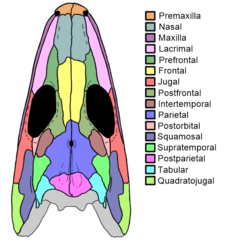Intertemporal bone
The Intertemporal bone is a paired cranial bone present in bony fish and certain extinct amphibian-grade tetrapods.[1][2] It lies in the rear part of the skull, behind the eyes.[3]

Many lineages of four-limbed vertebrates ("tetrapods" in the broad sense) have lost the intertemporal bone. These include Acanthostega, Icththyostega, colosteids (except for a vestigial intertemporal in Greererpeton),[4] diadectomorphs, lepospondyls, and amniotes. Lissamphibians (i.e. modern amphibians like frogs, salamanders, and caecilians) also lack an intertemporal. Most temnospondyls lack an intertemporal, though several early groups like edopoids, dvinosaurs, and various other basal taxa retain the bone.[5]
Tetrapod groups which do possess an intertemporal typically have it contact the parietal bone along its inner edge, the postfrontal and postorbital bones along its front and/or outer edge, and the supratemporal bone along its rear edge. Rarely, the intertemporal may also contact the squamosal bone at a point between its contact with the postorbital and supratemporal. When the intertemporal bone is lost, either the postfrontal and supratemporal lengthen to contact each other (or the tabular bone in case the supratemporal is also lost), or the parietal widens to contact the postorbital.[5]
References
- López-Arbarello, Adriana; Bürgin, Toni; Furrer, Heinz; Stockar, Rudolf (2016-07-19). "New holostean fishes (Actinopterygii: Neopterygii) from the Middle Triassic of the Monte San Giorgio (Canton Ticino, Switzerland)". PeerJ. US. 4: e2234. doi:10.7717/peerj.2234. PMC 4957996. PMID 27547543.
- Young, Ben; Dunstone, Robert L.; Senden, Timothy J.; Young, Gavin C. (2013-03-06). "A Gigantic Sarcopterygian (Tetrapodomorph Lobe-Finned Fish) from the Upper Devonian of Gondwana (Eden, New South Wales, Australia)". PLoS ONE. US. 8: e53871. doi:10.1371/journal.pone.0053871. PMC 3590215. PMID 23483884.
- Jollie, Malcolm (1986). "A primer of bone names for the understanding of the actinopterygian head and pectoral girdle skeletons". Canadian Journal of Zoology. 64 (2): 365–379. doi:10.1139/z86-058.
- John R. Bolt & R. Eric Lombard (2010). "Deltaherpeton hiemstrae, a New Colosteid Tetrapod from the Mississippian of Iowa". Journal of Paleontology. 84 (6): 1135–1151. doi:10.1666/10-020.1.
- Marjanović, David; Laurin, Michel (2019-01-04). "Phylogeny of Paleozoic limbed vertebrates reassessed through revision and expansion of the largest published relevant data matrix". PeerJ. 6: e5565. doi:10.7717/peerj.5565. ISSN 2167-8359. PMC 6322490. PMID 30631641.